Ready to unlock your full potential in the pool? Here are the best strength training exercises for swimmers to unleash the beast on your personal best times.
When it comes to swimming fast, every fraction of a second counts.
Swimmers go to considerable lengths (puns!) to swim their best on race day.
Whether that means shaving down, investing in wildly expensive tech suits, or completing countless laps in their pursuit of swimming excellence.
While nothing replaces the time in the pool, including mastering technique and developing the right energy systems, a comprehensive and targeted strength training regimen can play a pivotal role in a swimmer’s journey to success.
The right strength training exercises improve power and strength so that swimmers can explode off the blocks faster, hold a more efficient body position in the water, surge out turns, and maintain the muscular strength to hold their strokes together at the end of a race.
However, not all strength training exercises are created equal, and not all resistance exercises will help them pursue chlorinated excellence. (Sorry, bicep curls.)
In this guide, we look at the best strength training exercises for swimmers, the research that supports them, tips for implementing the exercises into your routine, and more.
Let’s dive in.
Strength Training Exercises for Swimmers
While there is a long list of strength training exercises swimmers can do to develop strength and power, in this guide, we will focus on 7 specific exercises.
They include:
- Bench press
- Squats
- Pull-ups
- Bench pulls
- Broad jumps
- Squat jumps
- Planks
Next, we will look at each exercise, the benefits for swimmers, and how to add them to your training routine for peak performance.
1. Bench Press
The bench press is a classic upper-body strength training exercise that can be done with a barbell or dumbbell. The bench press builds upper body strength, which is crucial for swimmers to generate power during the pulling motion of their strokes.
The bench press is also a great core-building exercise (especially with dumbbells) and works the pecs, shoulders, and triceps.
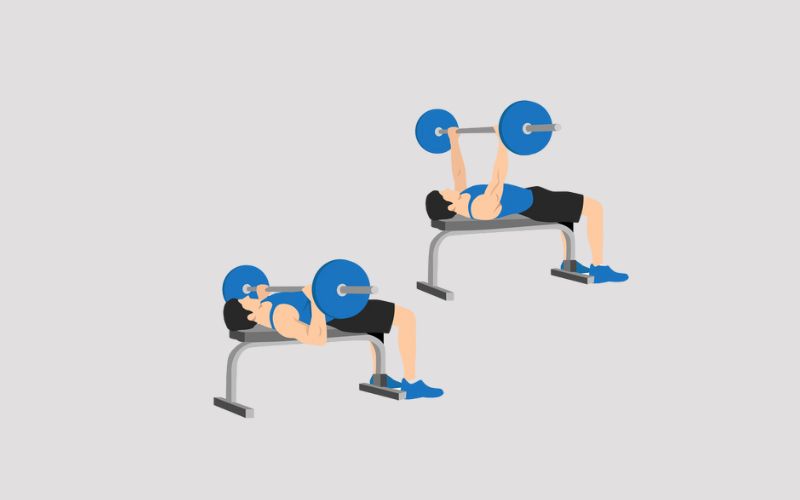
A study published in the Journal of Strength Conditioning Research, titled “The Influence of Upper- and Lower-Body Maximum Strength on Swim Block Start, Turn, and Overall Swim Performance in Sprint Swimming,” found that maximum strength in the bench press explained 50-65% of swimming power and 45-62% of performance variance in sprint swimming events.
Alrighty then!
Swimmers who want to add the bench press to their strength training routine should consider using the dumbbell bench press.
There are a lot of reasons I prefer DB vs. barbell, including increased safety (dumbbells are easier to ditch), neutral hand grip, and more scapular stability.
Dumbbells also allow for more variation, whether that means doing single-arm dumbbell bench press (absolutely LIGHTS your core on fire) or alternating dumbbell bench press, which more closely imitates the alternating arm movement of swimming freestyle or backstroke.
2. Squats
Squats are a compound strength training exercise that targets the lower body, especially the quads, glutes, hamstrings, and lower back.
Squats give swimmers the power to push off the wall with force, kick with more power, and launch themselves off the block like a rocket blasted into space.
They are also a sneaky exercise for a stronger trunk, which can help streamline the body and exert power through the upper body and the lower body.
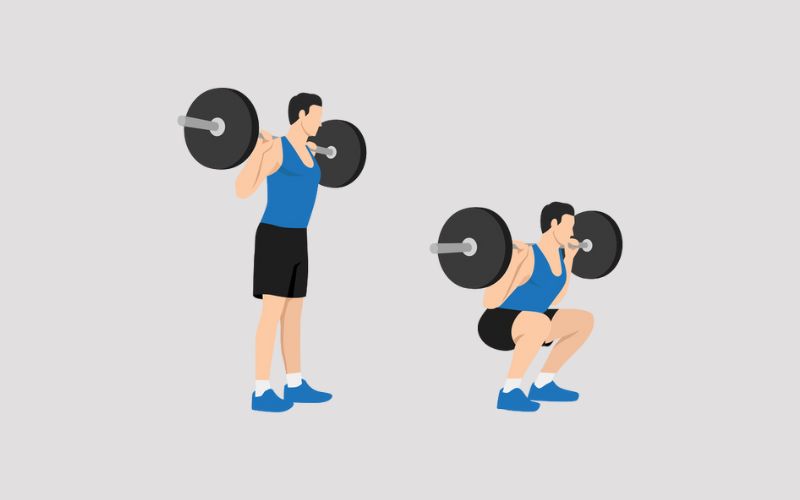
A study with a group of internationally-ranked male swimmers showed that start performance—how long it took for swimmers to reach 15m—was linked to lower body power and strength.
Another paper we mentioned earlier (Keiner et al., 2021) noted that 1RM squat strength positively correlated with swimming power and swim start performance.
Implementing squats into your strength training routine can be approached in a few different ways.
Beginner swimmers untrained in the gym have a bunch of squat variations they can use to master the movement, including:
- Bodyweight squats – Great for learning to balance when squatting and learning proper depth.
- Box squats – One of my favorites for overloading weight on the barbell, box squats are also an instructional squat variation for mastering depth and control.
- Wall squats – I still have nightmares about doing extended wall sits during my age group swimming days, with the memory of burning quads still fresh in my memory. Nevertheless, wall sits are great for teaching proper squat posture.
- Goblet squats – Holding a dumbbell close to your chest, Goblet squats are the next step in mastering the squat technique with light to medium resistance.
- Front squats – A more advanced version of the barbell squat, front squats are excellent for improved posture and, even though you use less weight, recruit as much leg muscle as back squats (Gullet et al., 2009).
Squats provide the strength and power foundation for more explosive strength training movements that swimmers can later implement into their routines.
Additionally, as you become proficient with squats and begin to crank up the weight, you will feel that extra power boost when pushing off the wall.
3. Pull-Ups
The pull-up is a classic strength training exercise for swimmers. It’s very versatile as well and can be done purely with body weight, with a band for assisted pull-ups, or by attaching weight plates to a dip belt for even more resistance.
Pull-ups work many muscles through the upper body and trunk, but swimmers primarily use them to target the latissimus dorsi, better known as the lats.
The latissimus dorsi is the “swimmer muscle” for a reason—it does a lot of heavy lifting (ha! Lifting pun!) for three of the swimming strokes (freestyle, backstroke, and butterfly).
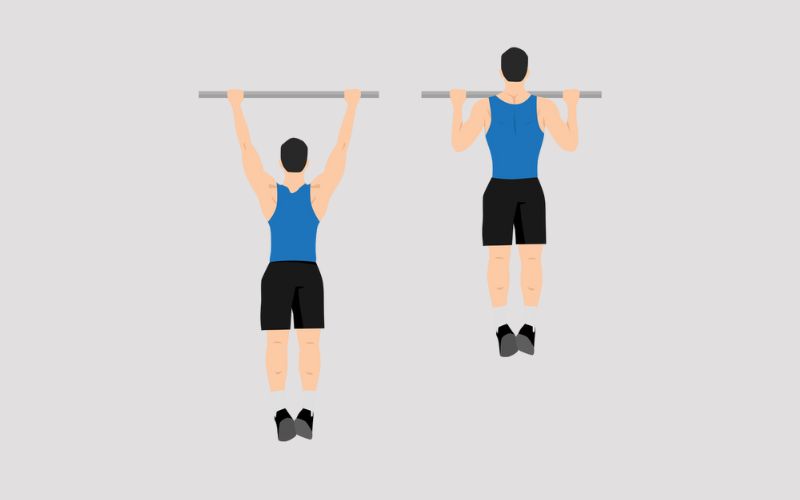
The lats provide stability for the shoulder joint and assist with generating power in overhead movements. Like when your hands are cutting into the water at the top of the stroke, and you are about to grab a whole handful of water.
Nathan Adrian, longtime national team member and Olympic gold medalist in the 100m freestyle, credits doing weighted pull-ups with improving his catch.
The trick with pull-ups, like any strength training, is control and technique.
A study titled “Relationship Between Dryland Strength and Swimming Performance: Pull-Up Mechanics as a Predictor of Swimming Speed” examined the link between pull-up technique and swimming speed.
See also: 10 Dryland Workouts for Swimmers
The researchers found that the fastest swimmers in the pool also had the best pull-up technique on the bar.
The number of total reps didn’t predict speed in the pool; the athletes who were most technically proficient on the pull-up bar blazed fastest across the length of the pool.
Just like your technique in the pool, focus on nailing the pull-up basics really, really well, and the gainz will come in short order.
- Fun Fact: Nathan Adrian, Olympic 100m freestyle champion and model of sprint consistency for the better part of a decade, could do reps of weighted pull-ups with over 130 lbs dangling from his waist.
4. Bench Pulls
The swim start is a huge part of swimming fast on race day.
Just ask anyone who has competed against Olympic champion and world record holder Caeleb Dressel and ask them how stoked they are to surface from the breakout half a body length behind in a 50m race.
A lot goes into having an excellent start, including explosiveness, technique, and mobility. One of the underrated ways to improve the swim start is with upper body pulling strength that can be developed with bench pulls, also known as a seal row.
Why bench pulls? And why for swimmers?
Well, the swim start requires power to pull the body forward once the starter’s gun goes off.
We will draw on research from luge athletes, who perform a swim start-like pulling motion at the beginning of each race to launch themselves down an icy track.
The study took a group of elite luge athletes and examined flexibility, trunk strength, isometric leg strength, and bench pull performance. The key difference between the athletes with a lightning-quick start and those who struggled to get out of the start was bench pull performance.
This intuitively makes sense: if a swimmer can “pull” on the block more powerfully, they will generate more power and velocity off of the blocks.
- Prop yourself up on a high-mounted bench (a regular height bench won’t do for this resistance exercise).
- Set up a barbell with the desired weight underneath the bench. Pull the weight up in a controlled manner, pause at the top, and lower.
- Keep your head in line with the spine and focus on pulling forcefully through the entire range of motion for maximum effect.
Australian sprinter Cam McEvoy, who at the 2023 World Championships swam a blistering 21.06 in the 50m freestyle, uses this specific exercise in his strength training.
Video courtesy of Brett Hawke:
5. Broad Jumps
Plyometrics and jumps have a pivotal role in strength training exercises for swimmers. Unleashing power and velocity off of the starts and turns are crucial for maximizing performance on race day.
One of the exercises every swimmer looking for a faster start should incorporate into their strength training is broad jumps.
Unlike squat or countermovement jumps, which focus on vertical power and have a mixed record in the research literature of being linked to improved swim start performance, the broad jump is a plyometric long jump focused on horizontal power.
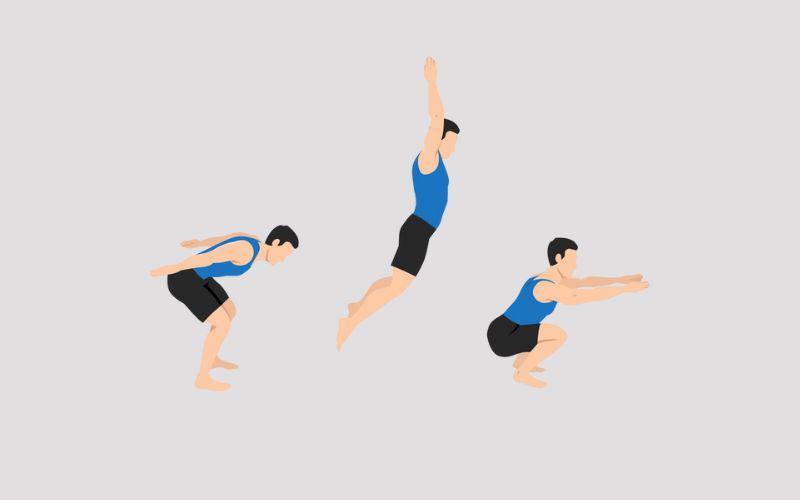
In other words, broad jumps help you get more distance and speed horizontally away from the block on race day.
A study published in the Journal of Strength Conditioning Research took a group of ten competitive swimmers and had them perform nine weeks of broad jumps.
The exercise was done twice a week, with 8×2 reps for two weeks, then progressed to 15×2 reps for the remainder of the intervention, with 15 seconds of rest between reps. The swimmers took a two-minute break between sets to maximize power and jumping velocity.
- Note: The platform for the jumps replicated the angle of a block used in competition.
By the end, the swimmers generated an additional 7% of horizontal force. Velocity was even better, with swimmers increasing horizontal velocity by a whopping 16%.
Pretty awesome for just two sessions per week and minimal time.
Broad jumps are a bodyweight exercise that doesn’t require any additional equipment, just a nice landing surface, full hip extension when performing the movement, and an athletic stance when you land after launching yourself across space and time.
6. Squat Jumps
Squat jumps are another plyometric exercise that is also a variation of squats. So, the best of both worlds!
Squat jumps help increase leg power, perfect for swimmers who want a more powerful kick and explosive push-offs.
One study (Sammoud et al., 2019) with competitive swimmers showed that adding squat jumps within an 8-week plyometric training program significantly increased overall jumping ability and swimming performance, particularly sprint efforts.
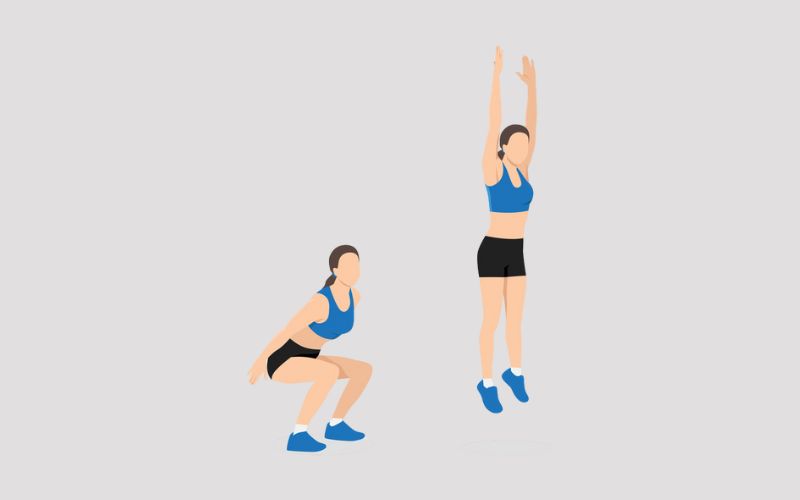
With squat jumps, the goal isn’t brute force. It’s controlled and explosive speed.
A typical mistake athletes will make with this exercise is to use too much weight, slowing down the velocity and turning it into a struggle session to get off the ground.
Squat jumps are not about moving heavy weight slowly, they are about moving light weight at lightning speeds.
A study published in the Journal of Strength and Conditioning Research titled “Power output in the jump squat in adolescent male athletes” showed peak power happened when athletes used just their bodyweight.
With squat jumps, go light and go fast.
7. Planks
Core strength is vital for swimmers. With optimal core strength, swimmers can transfer power through the limbs, whether by exerting more force in the pull, kicking harder, or exploding off the blocks with more velocity.
A strong core also helps to minimize the risk of injury, locks in your streamlines, and can even help facilitate stronger breathing.
A study with international-level swimmers showed a 6-week core strengthening program significantly improved 50m swim speed, increased velocity off the start, and increased turn speed.
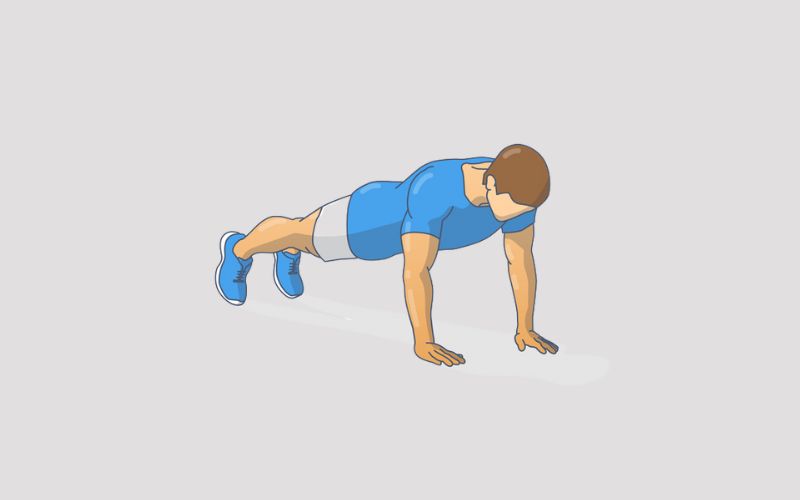
Not a bad list of benefits!
When it comes to core exercises for swimmers, nothing is more versatile than the plank exercise. It’s the Swiss Army knife of core exercises.
Suitable for beginners and adjustable for even the most experienced swimmers, planks make the cut when it comes to the best strength training exercises for swimming thanks to convenience, core strengthening, postural control, and versatility.
Here is a sample plank progression that swimmers can use to build core strength:
- Front planks – The O.G. can be done in a push-up position or on your forearms. Build up until you can hold it for 60-90 seconds.
- Side planks – Excellent for building lumbar stability, oblique strength, and anti-rotational strength.
- Planks with hip extension – Elevate one leg and hold for a 2-count in a regular plank position. Repeat on the other side.
- Two-point planks – Raise one arm and the opposite leg so that you only have two points of contact to the ground. Excellent for mastering stability.
- Weighted planks – Grab two jump squat boxes (or weight benches), attach a weight plate to a dip belt so that it dangles under your abdomen, and add resistance to this bodyweight exercise.
The goal with planks isn’t just to be able to do long, extended holds of 2 minutes or longer. But continually progressing with varying stimuli and difficulty to continue challenging and strengthening the core.
How much volume should swimmers do with strength training exercises?
Swimmers already face a challenging schedule with in-the-pool training. The two-a-days, the multi-hour swim workouts, and so on. This means finding the time and energy to devote to strength training can be challenging.
When it comes to programming reps and sets, lean towards the lower side of volume.
A paper titled “What Is the Optimal Strength Training Load to Improve Swimming Performance? A Randomized Trial of Male Competitive Swimmers,” took a group of competitive swimmers and had them perform strength training at different volumes.
The swimmers who lifted 3-4 sets of 3-5 reps at 85-95% intensity improved muscle strength and swimming performance as much as the other groups who did significantly more volume.
With strength training, especially when paired with the demands of swim training, more isn’t always better.
Should I combine resisted swimming with strength training?
Yes! While this article is focused on strength training outside of the pool, combining it with resisted swimming can help you get even faster.
While I will go wade further into the deep end with resisted swimming in a future article, here’s a quick teaser.
A paper published in the International Journal of Environmental Research and Health had a group of competitive swimmers do 9-weeks of concurrent resistance training in the water combined with strength training.
The in-the-water resistance training consisted of twelve 15m efforts with paddles and a swim parachute twice a week. This group showed significantly greater improvement than their unfortunate peers relegated to the control group.
In one example, the strength group averaged 13.14 for a sprint 25m before the intervention and improved to 12.24 at the end. Nearly a full second of improvement!
The control group improved as well, but by less than two-tenths of a second, starting at 13.13 and ending 12.97.
Wrapping Things Up
Nothing beats getting faster in the water.
And the good news is that no matter what level of swimmer you are, there are strength training exercises you can do to improve performance, whether that means getting off the blocks faster, tightening up your streamline, or delivering tsunami-like waves when dolphin kicking.
Incorporate these top swim-specific strength exercises into your training routine and dive into improved performance.
Image credits: The author
Disclaimer: Before beginning a new workout regimen and hitting the weight, remember to consult with a physician or healthcare professional to ensure that it’s the right fit for you.
ABOUT OLIVIER POIRIER-LEROY
Olivier Poirier-Leroy is a former national-level swimmer, author, swim coach, and certified personal trainer. He’s the author of YourSwimBook, a ten-month logbook for competitive swimmers.
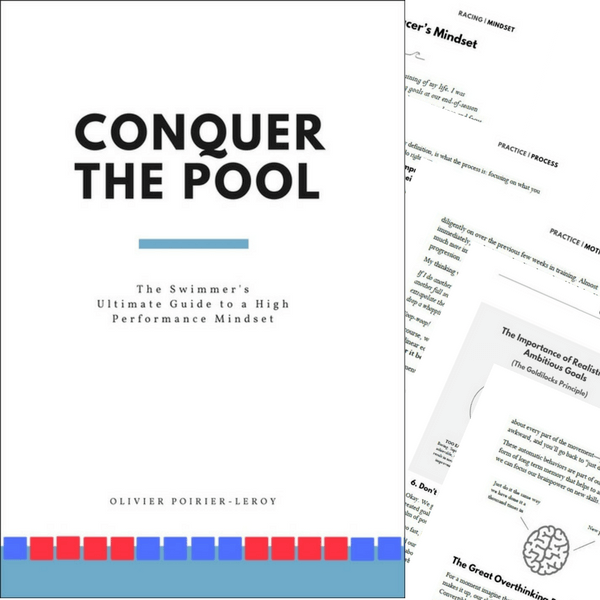 He’s also the author of the recently published mental training workbook for competitive swimmers, Conquer the Pool: The Swimmer’s Ultimate Guide to a High-Performance Mindset.
He’s also the author of the recently published mental training workbook for competitive swimmers, Conquer the Pool: The Swimmer’s Ultimate Guide to a High-Performance Mindset.
It combines sport psychology research, worksheets, anecdotes, and examples of Olympians past and present to give swimmers everything they need to conquer the mental side of the sport.
Ready to take your mindset to the next level in the pool?
Click here to learn more about Conquer the Pool.
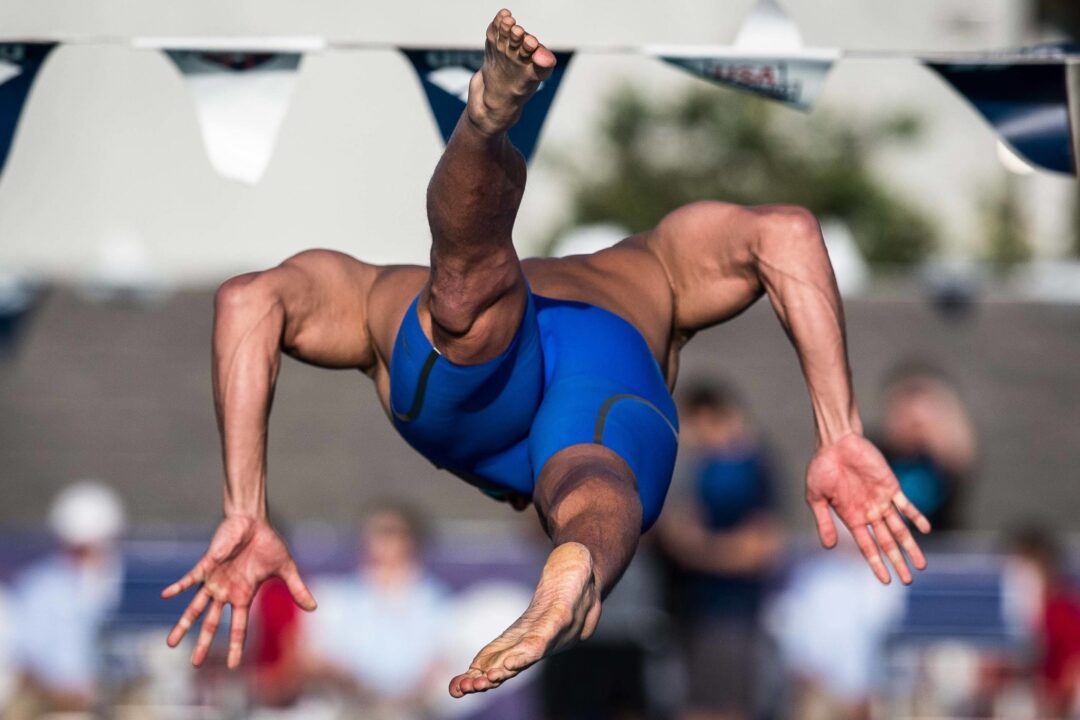
poop
what about training the slow twitch fibers instead of fast twitch. depends if your a long distance or sprinter right ?
Swimmers can benefit from having the gravitational forces that land bearing activities in magnitude of weight.
Excellent Article. Thanks 👍
Some reference values could really elevate this article imo.
Here are some i know of for international male sprinters (1RM):
Bench: 130-160 (Van Der Burgh @160), also 10x100kg in 11 seconds
Pull ups: 60-80kg + BW (several 21. freestylers and top breaststrokers in this range)
plank: 100kg in a short interval (Mcevoy)
bench pull: 110 kg mcevoy in this article
The squats and jumps are great, and I think swimmers can also benefit from posterior-chain focused movements like deadlifts and glute bridges. When you swim your spine is in extension all the time which can cause a strength imbalance in the small muscles that attach to the vertebrae. Strong glutes and hamstrings can help protect your back and prevent injury.
I can vouch that deadlifts strengthened my lower back, raised my explosiveness off the walls, and improved my UWs.
Since we’re citing the literature;
https://pubmed.ncbi.nlm.nih.gov/35099631/, I believe the best answer is something is better than nothing, but nothing is better than the rest.
Weighted Dips > Bench press…(dips allow your scapula to glide on their own properly which is better for your shoulders albeit Dips are stressful if done incorrectly without proper strength mobility and tissue resilience in the wrists elbows and shoulder joint) – high risk sure but high reward. Also sprint on land is great for taxing the nervous system (great for strength improvement)
Great additions!
Dumbbell bench better than both.
I don’t think high risk is a good bet if we’re talking about improving performance among the masses. Mitigating the risk of injury should be a big consideration.